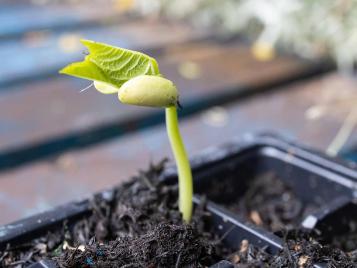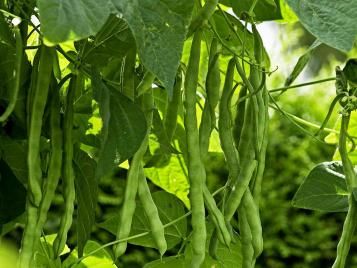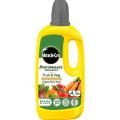

How to grow French beans
French beans are a versatile vegetable, producing attractive, long, thin pods, and creamy haricot beans. They are a heavy cropper, with each plant producing potentially hundreds of beans from each single bean sown. Like many other types of bean, they are a great nutritional source of protein and iron, and offer superb value as the seed can be saved and resown from year to year.
French beans, or Phaseolus vulgaris, can be climbing (pole) or dwarfing (bush) types. There are thousands of varieties to choose from, with variously coloured flowers and pods.
Climbing French beans are great where ground space is lacking, or where height will add interest to an area. Varieties to try include:
- ‘Blue Lake’. Green pods containing lots of pale green - white beans.
- ’Cobra’. Traditional green pods produced in abundance.
- ‘Golden Gate’. A very heavy cropper producing flat yellow pods.
- ‘Neckargold’. Very long round yellow pods.
- ‘Violet podded’. Attractive and easy-to-find mid-dark purple pods.
Dwarf French beans grow to about 30cm (1’) tall and can work well when grown around much taller plants, such as sweetcorn or climbing beans. They can be grown in a row or a square, or placed in gaps in the flower bed to create a ‘potager' effect. Varieties to try:
- ‘Barlotta’. Very attractive green pods speckled with red flecks.
- ‘Blauhilde’. Light purple flowers and long, dark purple pods.
- ‘Ferrari’. A quick grower producing straight green beans.
- ‘Purple teepee’. Purple pods reach an impressive 15cm (5") long.
- ‘Yin Yang’. Green pods, and spectacular black and white beans.
French beans can be sown throughout late spring and summer to keep more crops coming, so it’s worth trying several varieties.

What you’ll need to grow French beans
French Beans are frost-sensitive, so need to be given a head-start indoors. To do this you will need:
- French bean seeds
- A jar of warm water
- Seed tray or pots
- Multipurpose compost
- Dibber
From late April to mid-July:
- Add the bean seeds to the jar of warm water, and allow to soak for 12 hours.
- Fill a seed tray or pot with multipurpose compost.
- Use the dibber to create 5cm (2") deep holes in the compost. Allow 3-5cm (1-2") between seeds.
- Sow one seed in each hole, cover with compost and water well.
French beans germinate quickly, and you should see them sprouting after about a week.
Move the French beans outside once all risk of frost has passed, usually from mid-late May onwards. You will need:
- Long canes or sticks (for Climbing French Beans)
- String (for Climbing French Beans)
- A trowel or dibber
- French bean plants
To transplant them successfully:
- If growing Climbing French Beans, insert canes or sticks into the ground 15cm (6") apart and secure to one another with string.
- Use the trowel or dibber to create a hole big enough for each germinated bean root ball to fit. Create two holes around each pole for Climbing French Beans, or 1 hole per 30cm (1") for each Dwarf French Bean.
- Fill the hole with water, and allow to soak in.
- Place each plant in a hole, backfill with soil and firm in gently.
French bean seeds can also be sown directly in the soil throughout the summer. Sow more than needed as some are likely to be given up to slugs, snail and mice.
Where to plant and grow your French beans
Climbing French Beans can grow up to 2 metres (6') high, so grow in a sheltered position to protect the plants and supports from wind. Climbing French Beans can look great as a tall pyramid shaped centrepiece of a bed, or in a more traditional row.
Dwarf French Beans do not need support, and can be grown in the ground or in containers.
All French beans are tender, so have cloches or fleece ready to protect them when night-time temperatures are forecast to drop to below 10°C (50°F).
French beans will grow well in sandy, clayey, or medium soils. They prefer neutral or neutral-alkaline soil, which should be moist but well-drained. They enjoy full sun, but will tolerate shade as long as it is warm.
Caring and nurturing for your French beans
Check supports of Climbing French Beans to ensure they are sturdy and able to withstand strong winds. Water in spells of very dry weather to encourage flower production.
Harvest French bean pods from July through to October. This will help the plant to produce more beans. Snip them off with scissors. Always cook French beans before eating them to remove the poisonous ‘phytohaemagglutinin’ toxin.
Towards the end of the summer, leave some beans to ripen on the plant to be harvested as haricot beans or to grow again next season. The pods should at this point be brown and rattle when shaken. Remove from the plant and leave in a warm, dry place such as a windowsill. Crack open the crispy pods and place the beans in a container for eating throughout the coming months. Place a few in a labelled envelope for sowing next year.
French beans do not need feeding and can actually improve nitrogen levels in the soil. In the autumn, cut plants just above soil level, leaving the roots behind. These will help to boost nitrogen levels as they decay in the soil. The tops can be added to the compost heap.

Common pests and diseases with French beans
Established French beans are largely unaffected by pests and diseases, but there are a few worth looking out for…
Bean Mosaic Virus
The main symptom is puckering of leaves and gnarled pods. Control aphids which can spread the disease and remove badly affected plants.
Black bean aphid and blackfly
These cluster in large numbers around new growth, sucking sap, damaging leaves and flowers, and reducing the ability of the plant to produce beans. Squish by hand, and encourage predators such as ladybirds.
Slugs and snails
Slugs and snails can attack young plants which have just been planted out, and also young beans which are trailing on the ground. Remove by hand, encourage frogs, toads and hedgehogs which will predate them, and use grit to discourage them. See our helpful article for more tips on protecting French beans from slugs and snails.
Key features of French beans
| Flowering season(s) | Summer, Autumn |
|---|---|
| Foliage season(s) | Spring, Summer, Autumn |
| Sunlight | Partial shade, Full sun |
| Soil type | Chalky, Clay, Loamy |
| Soil pH | Alkaline |
| Soil moisture | Moist but well-drained |
| Ultimate height | Climbing varieties up to 1.8m (6ft) |
| Ultimate spread | Up to 60cm (2ft) |
| Time to ultimate height | 3 months |




